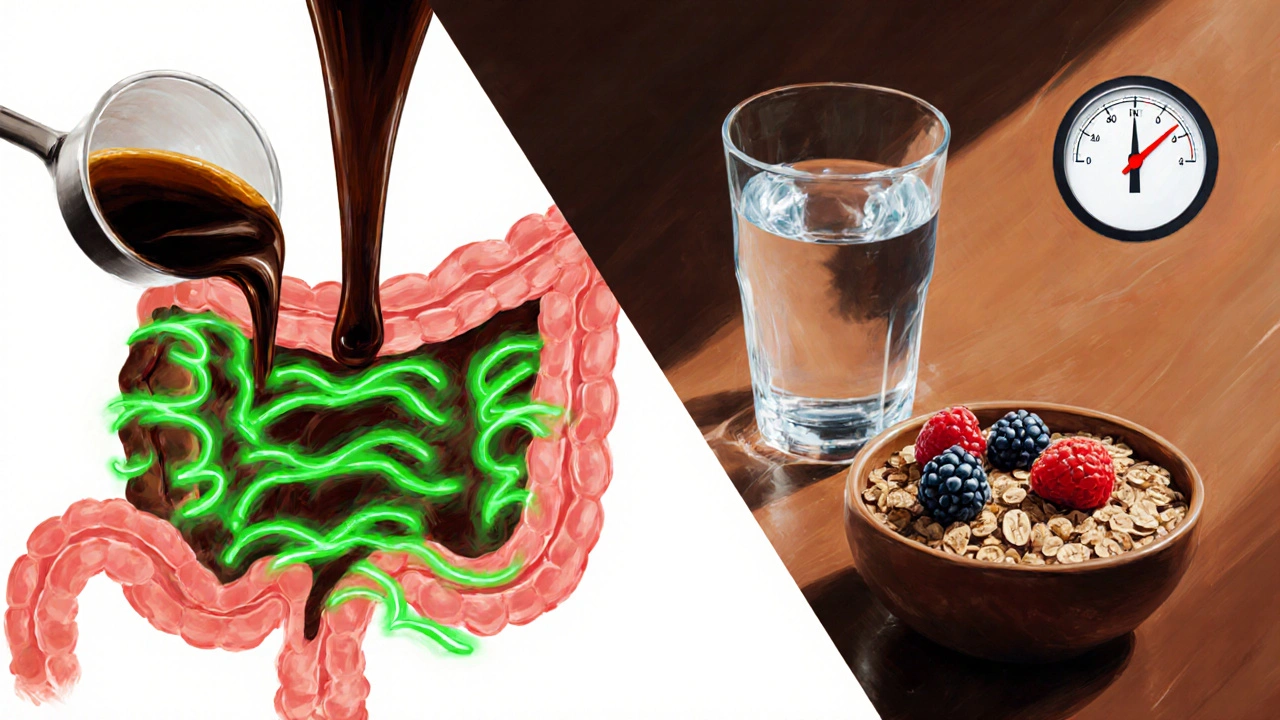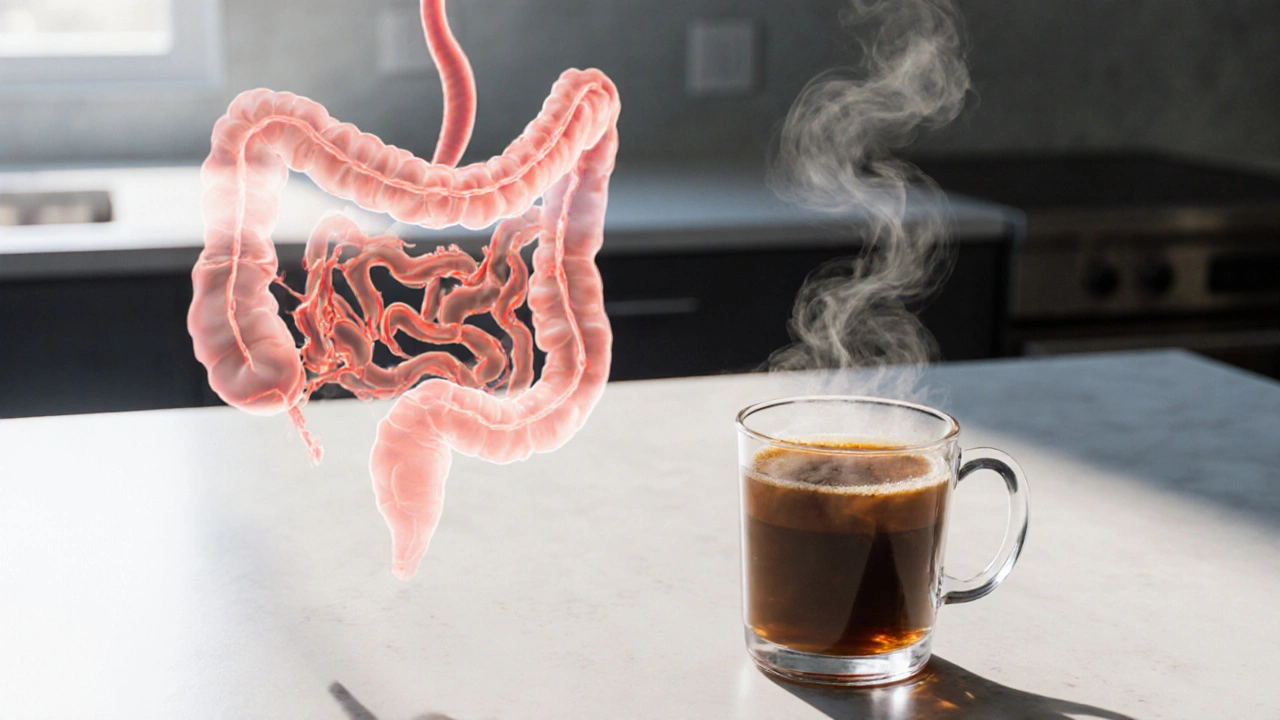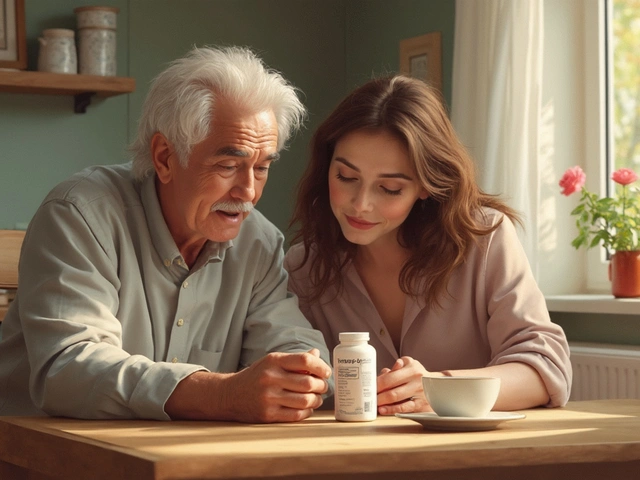Coffee & Hemorrhoids Impact Calculator
Your Coffee Habits
Hemorrhoid Symptom Severity
Your Personalized Risk Assessment
If you’re reaching for a cup of morning coffee and notice a flare‑up in your Hemorrhoids - a condition where swollen blood vessels in the anal region cause pain, itching, or bleeding, you’re not alone. Many people wonder whether the caffeine buzz is a hidden trigger. In this article we’ll break down what caffeine actually does to the Colon - the long tube that moves waste through your body - how it can affect the muscles that control the anal opening, known as the anal sphincter, and what practical steps you can take to keep your symptoms in check.
What Is Caffeine and Why Do We Love It?
Caffeine is a natural stimulant found in coffee beans, tea leaves, cacao pods and a few other plants. It works by blocking adenosine receptors in the brain, which normally tell you to feel sleepy. The result is a temporary boost in alertness, heart rate, and, for many, a good mood.
While that rush feels great, caffeine also nudges the rest of your body. It can speed up the heart, increase blood pressure, and stimulate the gastrointestinal tract - the network that includes the Gastrointestinal tract - the stomach, small intestine, and large intestine - that processes everything you eat.
How Coffee Specifically Interacts With Your Digestive System
When you sip a brewed cup, you’re not just getting caffeine. Coffee also delivers chlorogenic acids, magnesium, and a modest amount of oil that can act as a mild laxative. For some people, that means a quicker bathroom trip; for others, it can create a crampy, uneven bowel movement.
The key players in a hemorrhoid flare are:
- Blood vessels - tiny tubes that can swell and inflame, leading to the classic lumps around the anus.
- Anal sphincter - the muscle ring that must relax for a smooth stool pass. If it stays tight, pressure builds up in the veins.
- Dehydration - when your body lacks enough water, stools become hard, forcing the sphincter to work harder.
All three can be nudged by coffee, but the extent depends on how much you drink, what sort of coffee it is, and your overall diet.
Direct Ways Caffeine May Worsen Hemorrhoid Symptoms
1. Increased intestinal motility - Caffeine stimulates the colon to contract, a phenomenon called the gastrocolic reflex. For people with hemorrhoids, a sudden, forceful bowel movement can stretch those delicate veins.
2. Dehydrating effect - Caffeine is a mild diuretic, meaning it prompts kidneys to excrete more water. If you don’t counterbalance with extra fluids, stool consistency can become dry and hard, raising the risk of straining.
3. Blood pressure spike - A short‑term rise in blood pressure can cause the already‑engorged Blood vessels in the anal area to swell a bit more, intensifying pain or itching.
4. Acidic environment - Coffee’s natural acids can irritate the lining of the colon and rectum, especially if you have an existing inflammation.
Indirect Factors: Lifestyle, Fiber, and Stress
Even if caffeine’s direct impact feels mild, the habits that surround coffee drinking can add up. Most coffee lovers pair their brew with pastries, sugary snacks, or a quick‑grab sandwich low in Dietary fiber - the plant‑based carbohydrate that adds bulk to stool and helps it pass smoothly.
Lack of fiber forces the colon to work harder, which again pressures the anal sphincter. Combine that with a caffeine‑induced urge to go, and you have a recipe for an uncomfortable bathroom visit.
Stress is another hidden player. The caffeine‑induced “fight‑or‑flight” response can tighten muscles throughout the body, including the pelvic floor. A tight pelvic floor means the anal sphincter stays less relaxed, again raising internal pressure.

Practical Tips: Enjoy Your Coffee Without the Flare‑Ups
- Watch your portion size. A standard 8‑oz cup contains about 95mg of caffeine. If you’re sensitive, limit yourself to one cup a day or switch to a smaller “espresso‑shot” style drink (≈63mg).
- Stay hydrated. For every cup of coffee, drink an extra glass of water. Aim for at least 2L of total fluid daily, more if you’re active or live in a hot climate like Darwin.
- Boost fiber intake. Add a handful of berries, a tablespoon of ground flaxseed, or a slice of whole‑grain toast to your breakfast. Aim for 25‑30g of fiber per day.
- Consider low‑acid or cold‑brew options. Cold‑brew coffee tends to have lower acidity, which may be gentler on the colon.
- Time your coffee strategically. Drink it at least an hour before a planned bathroom break. This gives the colon time to move the stool gradually rather than all at once.
- Try decaf or half‑caffeinated blends. Decaf still contains a tiny caffeine amount (5‑15mg) but can satisfy the ritual without the strong stimulant effect.
- Move your body. Light walking after coffee can help stimulate a smoother bowel movement without forcing a rapid, hard push.
If you notice that symptoms worsen despite these tweaks, it might be worth a short break from coffee for a week. Track your pain, itching, and bleeding logs; you’ll often see a clear pattern.
When to Seek Professional Help
Most hemorrhoid flares resolve with lifestyle changes, but certain signs suggest you need a doctor’s evaluation:
- Bleeding that lasts more than a few days or is heavy enough to tint the toilet water.
- Pain that interferes with daily activities or sleep.
- Any lump that continues to grow or becomes hard.
- Symptoms that persist despite cutting back on caffeine and improving fiber intake.
Procedures range from simple rubber‑band ligation to minimally invasive laser therapy. Your doctor will tailor the approach based on severity and your overall health.
Comparison of Common Coffee Types and Their Caffeine Content
| Coffee Style | Caffeine (mg per 8oz) | Acidity (pH approx.) | Typical Effect on Hemorrhoids |
|---|---|---|---|
| Drip (regular) | 95 | 4.85 | Moderate - can increase bowel urgency and mild dehydration. |
| Espresso (single shot) | 63 | 5.00 | Lower volume but still stimulating; less overall fluid loss. |
| Cold‑brew | 100‑110 | 5.20 (lower acidity) | Higher caffeine but gentler on colon lining. |
| Decaf | 5‑15 | 4.90 | Minimal stimulant effect; safe for most hemorrhoid sufferers. |
Notice how the coffee with the lowest acidity (cold‑brew) still packs a punch of caffeine. If you’re sensitive to the stimulant side, choose a decaf or half‑caff blend rather than just relying on low‑acid benefits.
Quick Take‑aways
- Caffeine can speed up colon contractions, dehydrate you, and raise blood pressure - all factors that may aggravate hemorrhoids and caffeine-related symptoms.
- Balancing coffee with extra water, fiber, and low‑acid options reduces risk.
- Monitor your body; a short coffee break can reveal if it’s the main trigger.
- Seek medical advice for persistent bleeding or severe pain.
Frequently Asked Questions
Can drinking coffee cause hemorrhoids to appear for the first time?
Coffee alone rarely creates hemorrhoids from scratch. Hemorrhoids develop from chronic pressure on the anal veins - often due to constipation, prolonged sitting, or pregnancy. However, caffeine can accelerate the onset if you already have small, hidden veins that become inflamed under the added stress of rapid bowel movements.
Is decaf safe for people with hemorrhoids?
Generally, yes. Decaf contains minimal caffeine, so it won’t trigger the gastrocolic reflex as strongly. The main thing to watch is the accompanying sugar or cream, which can alter gut bacteria and affect stool consistency.
How much water should I drink with each cup of coffee?
A good rule of thumb is one 8‑oz glass of water per cup of coffee. This helps offset the mild diuretic effect and keeps stool soft. If you’re exercising or in a hot climate, add another glass.
Are there specific foods I should pair with coffee to protect my hemorroids?
Yes - foods high in soluble fiber, like oats, chia seeds, apples, and beans, can bulk up stool and reduce straining. Adding a spoonful of ground flaxseed to your coffee or having a whole‑grain toast on the side works well.
Should I avoid coffee completely during a hemorrhoid flare?
Not necessarily. Many people tolerate a small, low‑acid cup fine if they keep hydrated and consume enough fiber. If you notice immediate worsening, cut back temporarily and re‑introduce slowly while monitoring symptoms.



amanda luize
4 October / 2025Look, the caffeine agenda isn’t just about staying awake – it’s a calibrated weapon to keep the masses jittery, so you ignore the subtle warning signs your body throws at you. If you’re dealing with hemorrhoids, the diuretic buzz will only dehydrate you further, making stools rock‑hard and forcing that sore sphincter to grind like a stuck gear. The industry loves to hide the fact that each extra cup adds an invisible pressure spike to the anal veins, and they’ll never tell you because they profit from your discomfort. Stay vigilant, hydrate, and consider cutting out the brew before you end up funding their next big stimulant rollout.